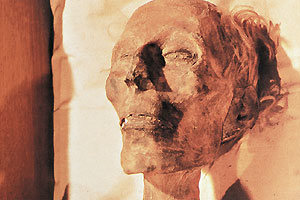After expelling the Hyksos, Pharaoh Ahmosis I restored Egyptian rule over Nubia. He also took advantage of the opportunity to consolidate central power over the nobility’s feudal system. His rule began the XVIII dynasty and lay the foundations for the New Kingdom (1567 – 1085 B.C.).
His successor, Amenophis I, carried on with the campaigns in Nubia and separated tombs and temples, which had been united until then. Afterwards, Tutmosis I stuck to the policy of territorial expansion in Nubia and Asia.
When Tutmosis III was appointed Pharaoh, he was still a minor. Therefore, his aunt Hatshepsut ruled on his behalf for 18 years, during which she repaired monuments that had been ravaged by the Hyksos and promoted trade with Nubia and Punt. After her passing, Egypt reached maximum expansion as Tutmosis III led his forces to the Euphrates River.
The subsequent Pharaohs consolidated Egyptian rule and made peace with the powerful Mitanni Kingdom ( or Hurrian Kingdom, located in modern northern Syria). Among these pharaohs, Amenphosis III stands out as a great diplomat and promoter of the construction of monuments and temples.
The one god
The rise to power of Amenphosis IV as Pharaoh marked the beginning of the era known as El -Amarna, when worship for only one god, Aten, the Sun, was established. The ruler changed his name to Akhenaton and fought against the excessive power of the Priests of Amon. He closed down temples and confiscated their wealth. He also moved the capital to Akhetaton.
Some years after Akhenaton’s death, his son in law, the adolescent Tutankhamen, ascended the throne. With time and under the influence of the priests of Amon, he reestablished Amon’s worship and Thebes as the capital of the empire.
His death, at the tender age of 18, brought the XVIII Dynasty to an end. General Horemheb suceded him as regent and reorganized the state.
The XIX dynasty
This dynasty begins with Ramses I. His son, Seti I reestablished Egypt as a great power by defeating the Syrians, Libyans, and other Asian peoples as well undertaking the construction of the Temple of Abu Simbel.
Ramses II made peace with the Hittites and brought a great period of stability. During this period, the Pharaoh built colossal structures and buildings among other things. Merneptah succeeded his father Ramses II and during his reign, Egypt’s role as arbitrator of Asia diminished.
Ramses III, who belonged to the last dynasty of the New Kingdom, the XX, managed to repel new invaders (Acheans and peoples from Asia Minor) thus earning Egypt a short period of peace.
Thereafter, a divided Egypt began loosing influence in the Near East, with constant internal struggles that eventually led to the rule of two parallel dynasties: on the one hand, the successors of Ramses XI, whose rule was seated in Tanis; on the other, the dynasty of the Priests of Amon, the capital of which was Thebes.
Decadence of the third kingdom or third intermediate period
The XXII Dynasty of Libyan descent was the first of this period. Its capital was Bubastis and its first Pharaoh was Sheshong I, who successfully attacked Israel to recover the Palestinian lands. The victory enabled Egypt to become the feudal lord of the small Asian principalities. However, the weakness of Egypt’s power and domestic economic problems brought this Dynasty to an end.
As Egypt grew more and more divided, and kings took the throne simultaneously in different parts of the country, Tefnkahte, of Libyan ancestry, declared himself Pharaoh in the North and founded the XXIV Dynasty. It was also called the Sais Dynasty, and it coexisted with the XXII and the XXIII Dynasties.
The XXV Dynasty was Nubian and began around 715 B.C. Its influence spread to all the Nile Valley, but was halted the Assyrians. In the 6th century B.C., Psametic I restored Egypt’s splendor by expelling the Assyrians from the territory.
However, the ongoing wars with different states began to undermine Egypt’s capacity to remain autonomous and maintain internal stability. Some peoples, such as the Chaldeans and the Jews took advantage of this to exercise influence and preside over their own fate. Finally, it was the Persians who conquered the land of the Pharaohs when Cambyses defeated the Egyptian army and the country lost its independence.
The subsequent conquest of Alexander the Great, and later, the Roman invasion, made of Egypt a player in the East once more. However it was no longer an autonomous power.








 Muere Evita
Muere Evita